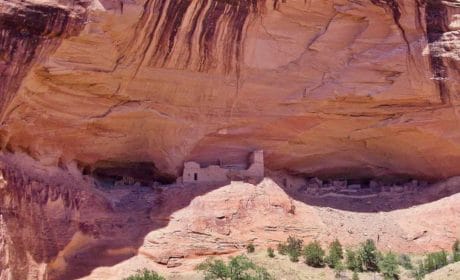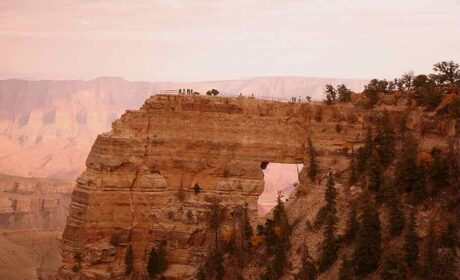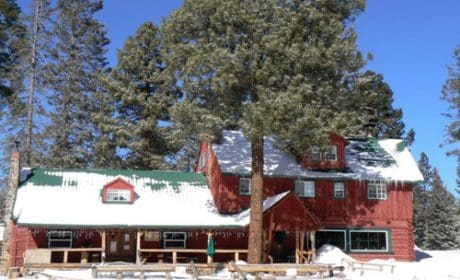Have you thought about visiting the North Rim of the Grand Canyon? Keep reading as I share our personal experience at the Grand Canyon North Rim and tips for planning your trip.
A trip to the Grand Canyon in northern Arizona is a once-in-a-lifetime travel experience. Over the course of 5 to 6 million years, the Colorado River has carved a 277-mile path through layer upon layer of geology creating a gorge that’s a mile deep. Luckily for us, our forefathers were wise enough to preserve 1.2 million acres as Grand Canyon National Park.
Alan and I visited the North Rim of the Grand Canyon on a fall national park road trip that took us from Arizona to the Canadian Rockies. Driving across the Kaibab Plateau (elevation 8,000 to 9,000 ft), fall foliage in Kaibab National Forest accompanied our national park trip, something we didn’t expect to see on an approach to the Grand Canyon.
Table of Contents
North Rim Grand Canyon or South Rim, which is better?
As the crow flies, only 10 miles separate the North and South Rims of Grand Canyon National Park (official website). However they are worlds apart when it comes to climate and travel experience.
I prefer the North Rim of the Grand Canyon for a less-crowded, more relaxed national park trip. Due to the North Rim’s higher elevation, 1,300 ft higher than the South Rim, you’ll also experience cooler temperatures.
In the summer, temperatures are 5 to 10 degrees lower than the South Rim. On those triple digit days of an Arizona summer, I consider that a big bonus.
However my choice is to visit either (or both) rims of the Grand Canyon in the fall. The South Rim will be somewhat less crowded than summer but you’ll feel as if you have the North Rim to yourself.
During our fall road trip to the North Rim, golden leaves of quaking aspen trees shimmered in the light breeze on a crisp, autumn day. And we saw plenty of wildlife, like turkey and mule deer, playing in the 10-mile long meadow, De Motte Park, on the west side of Kaibab Plateau-North Rim Parkway (the only paved access to the North Rim).
What a wonderful visual treat to travel next to meadows bordered by ponderosa pine forests that continue to the very edge of the Grand Canyon. It gives this side of the canyon a totally different feel.
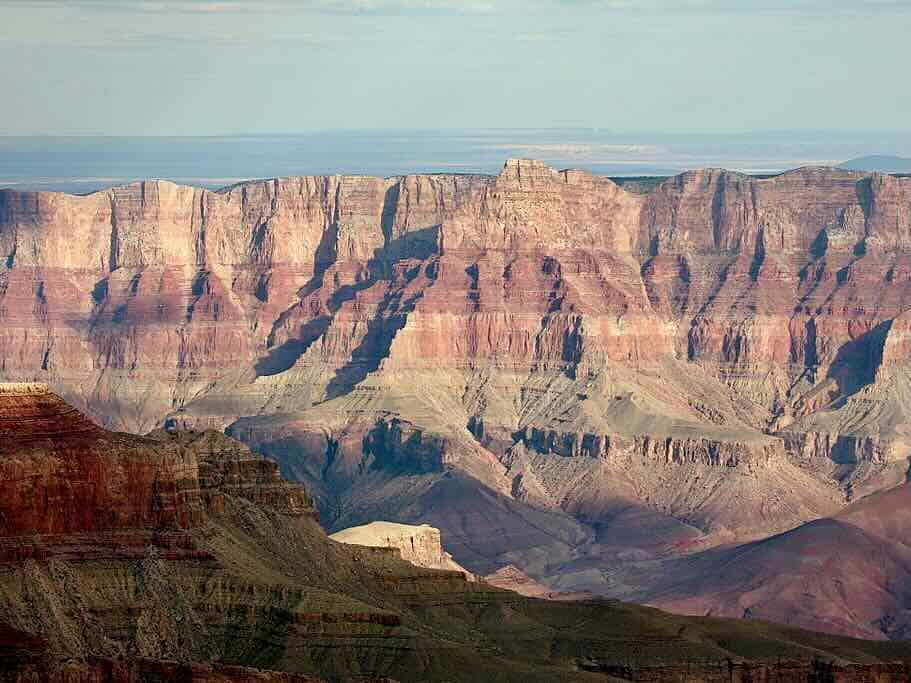
Of course if this is your first visit to the Grand Canyon, you’ll definitely want to explore the more commercial South Rim. Everyone should see the South Rim at least once in their lives.
But be aware that you’ll be joining many visitors as you admire viewpoints like Mather Point, Yavapai Point or hike beneath the rim on portions of Bright Angel or South Kaibab trails. Some visitors prefer the South Rim because it is more developed offering many lodging and dining options.
Although South Rim viewpoints are spectacular, most don’t allow you to see to the bottom of the canyon. If your goal is to see the Colorado River shining from the depths of the canyon surrounded by striated walls colored olive, rust and beige, visit the North Rim.
For those boomer travelers, like me, who enjoy a more off-the-beaten-path travel experience with fewer visitors, the North Rim is your best choice.
Best things to do on the North Rim for boomer travelers
Boomers will find plenty to do at the North Rim that don’t require hiking to the bottom of the canyon. You could spend most of the day taking a scenic drive, or try one of the moderate hikes or mule rides. But you’ll want to save time for short walks to scenic overlooks at sunrise and sunset.
The North Rim Visitor Center is a good place to start. Rangers are available to answer your questions (and lead special hikes and tours). Save time to browse the interpretive exhibits about cultural and natural history as well as the interesting collection of books at the Grand Canyon Association bookstore located inside the visitor center.
Take a North Rim scenic drive
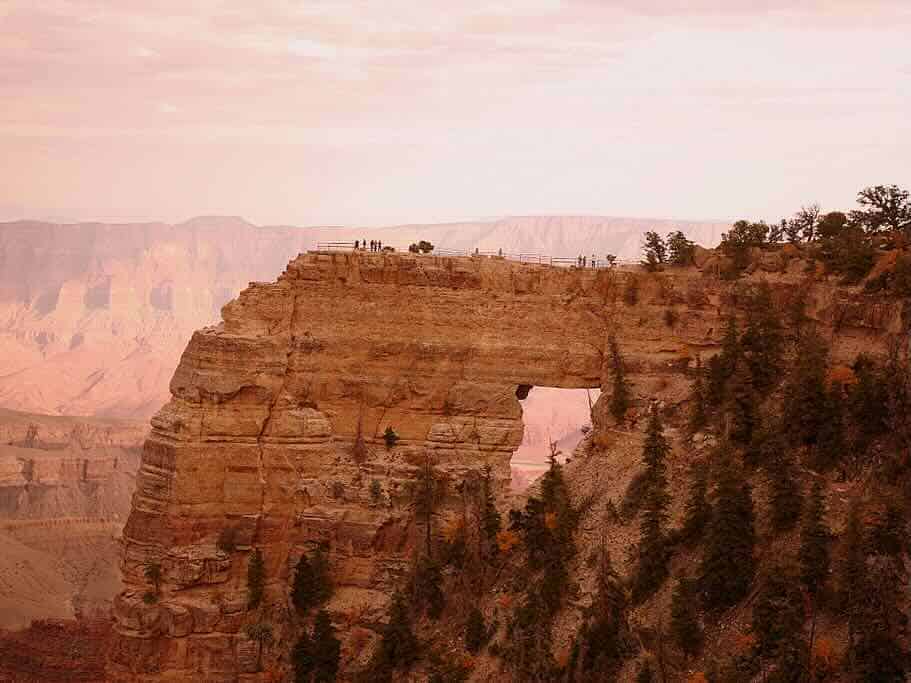
Alan and I thoroughly enjoyed the 23-mile drive along Cape Royal Rd that crosses the Walhalla Plateau, ending at Cape Royal. If you only have one day to explore, this drive is a must and one of the best things to do in Grand Canyon North Rim.
You’ll get your fill of stupendous views into the canyon along Cape Royal Rd. There are also many opportunities to get out of the car for walks to scenic overlooks. So take your time to enjoy the drive.
At the end of road, Cape Royal sits at an elevation of 7,865 feet commanding expansive Grand Canyon views. In fact, it’s one of best viewpoints on both the North and South Rims. This is a highlight not to be missed, especially at sunset.
Point Imperial is another outstanding viewpoint along Cape Royal Rd. At 8803 feet, Point Imperial is the highest point in Grand Canyon National Park.
Because Point Imperial is the northernmost overlook of the Grand Canyon, you’ll get a different perspective from other viewpoints. The geology is especially interesting with glimpses of Precambrian rocks colored red and black, which you won’t see in other areas of the North Rim.
Be sure to pick up The North Rim pocket map and services guide, available at the park entrance, visitors center or download here, to plan your drive.
Day Hiking on the North Rim

You’ll find plenty of hiking options on the North Rim. From easy walks along rimside trails to an adventurous hike into the canyon, there’s a trail for every level of hiker. Here are some of the best day hikes on easy to moderate trails (with one strenuous one included for you hardy hikers).
Bright Angel Point Trail
You won’t be alone on this short walk (0.5 miles round trip on pavement) to the most popular observation point on the North Rim, Bright Angel Point. Popular at sunrise or sunset (for good reason), the steep, paved trail is worth walking at different times of day to see the colors of the Grand Canyon change before your eyes.
Transept Trail
Connecting Grand Canyon Lodge to North Rim Campground, the moderately easy Transept Trail winds through the forest along the edge of a side canyon (Transept Canyon). You might see mule deer or other wildlife along the 2-mile one-way path that’s always fairly busy.
There are also a couple of steep sections, but nothing too difficult. Returning via the Bridle Trail turns this into a loop hike.
Cape Final Trail
Cape Final trailhead is located on the road to Cape Royal. Look for a turnoff about 2.5 miles north of the Cape Royal parking area.
The mostly level, four-mile-round-trip hike takes you to a viewpoint with expansive views of the eastern Grand Canyon. You’ll see Vishnu Temple and Jupiter Temple from here.
You’ll also be standing on the easternmost top of the Walhalla Plateau. If you’re traveling with grandkids, this hike is for you.
Boomer Travel Tip
Take a look at our day hiking essentials before heading down the trail.
Point Imperial Trail
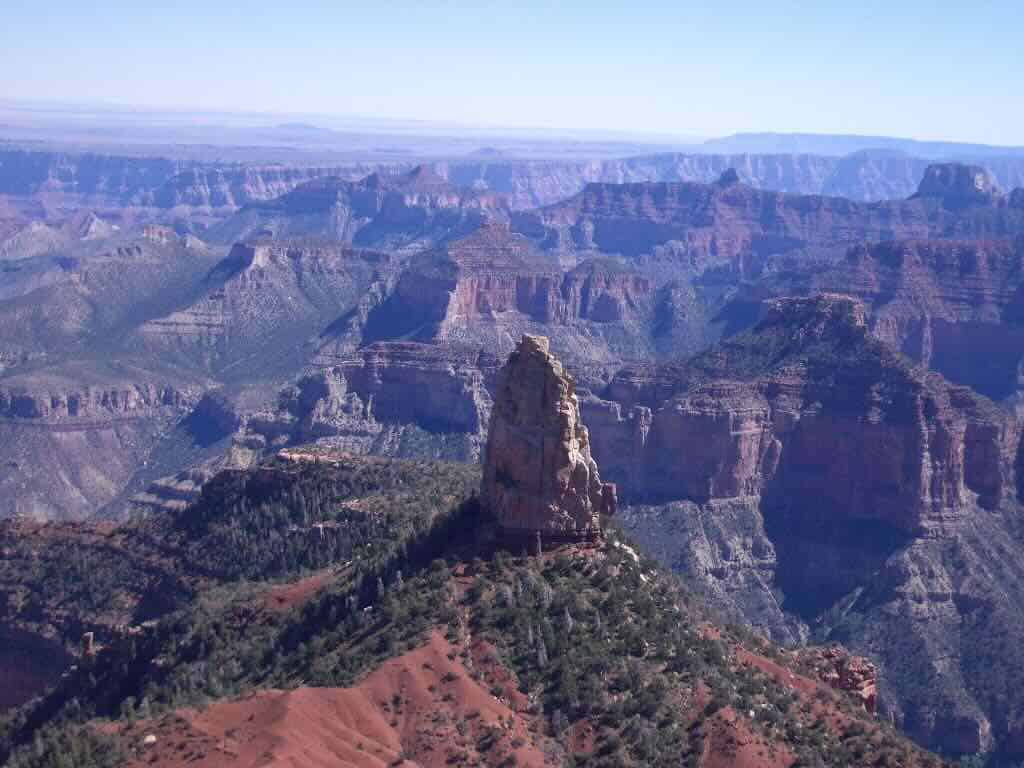
After admiring the view at Point Imperial, enjoy this easy four-mile-round-trip hike. Although it passes through a burn area from the 2000 Outlet Fire, you’ll also be hiking along the plateau’s edge with excellent views of upper Nankoweap Creek.
The trail ends at the north park boundary. It’s possible to continue on, connecting with Nankoweap Trail, a wilderness route to the Colorado River (you’ll need a permit and backcountry hiking skills).
North Kaibab Trail to Roaring Springs
A strenuous day hike into the canyon is possible by taking the North Kaibab trail to Roaring Springs (9.4 miles round trip). Descending 3050 ft. to the turn-around point and back up again will take 7 to 8 hours.
You’ll pass through two interesting narrow sections on this rim to river trail, Supai Tunnel and Eye of the Needle. The National Park Service discourages day hikers from continuing beyond Roaring Springs, although the 28-mile journey to the Colorado River makes a fun multi-day hike (you’ll need a permit for Cottonwood Campground or a Phantom Ranch reservation).
The National Park Service website maintains a complete listing of North Rim hikes (check it out here). Please take time to read the safety tips.
Boomer Travel Tip
Falcon Guides publishes a comprehensive hiking book for the North and South Rim of the Grand Canyon. Take a look.
Take a Grand Canyon mule ride
Experiencing the North Rim from the back of a mule is the ultimate Grand Canyon experience. And there’s a choice for every level of rider.
If your goal is to ride down into the Grand Canyon, book the steep, three-hour mule ride on the North Kaibab Trail. The journey turns around at Supai Tunnel, where you’ll stop to take photos (and a restroom break).
The three hour trip to Uncle Jim’s Point, a beautiful spot overlooking the North Kaibab Trail, is another option. This is a good choice for those who are afraid of heights.
Relaxing on a one-hour ride through the Kaibab Forest is an option for those who want to say they rode a mule at the Grand Canyon but don’t want the adventure of riding into the canyon. You’ll stay mostly in the forest with some canyon rim views.
Best three comprehensive views of the Grand Canyon are on the North Rim!
The North Rim provides the best three comprehensive views of the Grand Canyon. However one is easy to reach while the other two require more effort.
Point Imperial
As you begin the drive on Cape Royal Road, you’ll come to an intersection after about 5 miles. Cape Royal Road veers to the right. But a jog to the left travels 2.7 miles to Imperial Point, the highest viewpoint in Grand Canyon National Park at 8,803 ft.
You’ll see expansive views of the Painted Desert along with the eastern end of the Grand Canyon. You’ll also notice more color on the canyon walls. It comes from layers of red and black Precambrian rocks not visible at other overlooks.
Toroweap (now known as Tuweep)
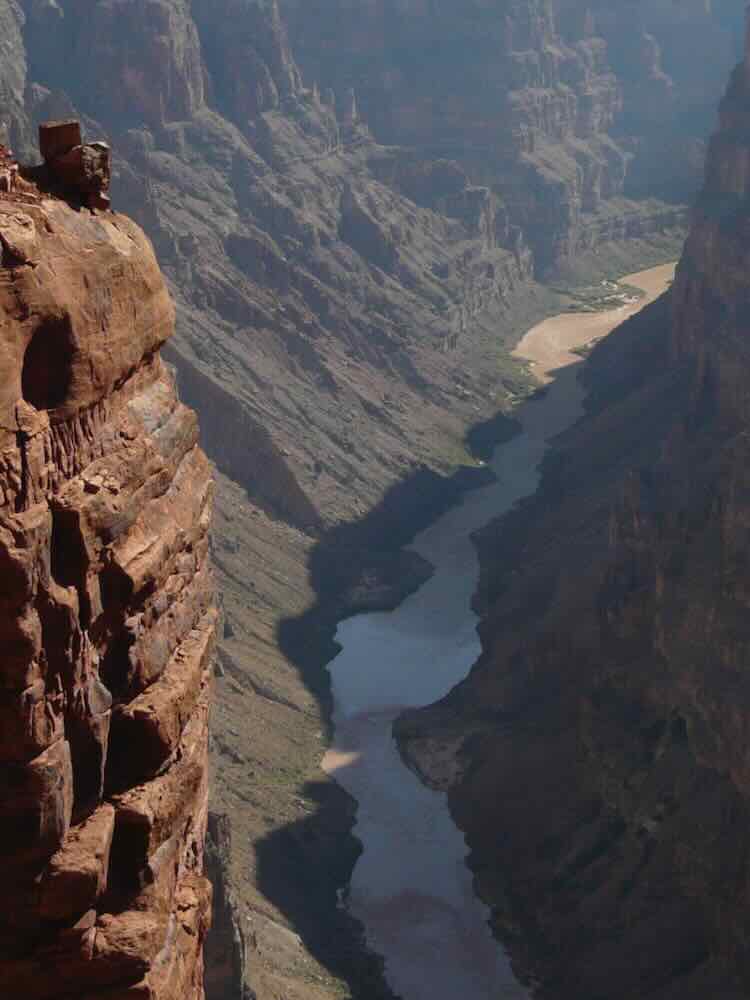
Toroweap (park website), or Tuweep, offers outstanding views in a remote corner of the Grand Canyon. This backcountry adventure, located on the northwestern edge of the Grand Canyon, requires planning, good weather (dirt roads become impassable with rain, thunderstorms or snow), and permits.
There are no services including food, gas, cell service, or lodging. You are truly on your own. Flat tires are common so travel slowly, 30 mph is suggested. Be sure to bring a spare tire or patch kit.
Alan traveled to Toroweap some years ago on a solo photography trip (I don’t dry camp). The 61-mile dirt road drive on the slow going Sunshine Route (the best route) makes for a very long day. While a day trip is doable, camping overnight is the best option (you’ll need a backcountry permit).
Why is the trip to Tuweep worth it? You’ll gaze (watch your step!) over the edge of a 3,000 ft sheer rock drop into the Colorado River. You can also see and hear Lava Falls, the Colorado River’s most challenging rapid, from here.
As of 2023, the National Park Service requires a $2 day use permit purchased in advance (in addition to your National Park pass) to visit Tuweep (Toroweap). Sadly, excessive visitation to this remote destination is causing overcrowding and traffic congestion.
Point Sublime
The gnarly road to Point Sublime might surprise you. Rather than the rocky desert landscape of Toroweap, you’ll travel through alpine forests and meadows of the Kaibab National Forest.
The one-way 17.7-mile-road to Point Sublime requires high clearance and four wheel drive is recommended. So why is it gnarly? Steep drop-offs on both sides of the road accompany your last four miles of the drive.
The reward is standing on a peninsula that juts out into the Grand Canyon. The unobstructed views are jaw dropping. This drive is definitely on the list for our next visit.
Best places on the North Rim to photograph sunrise and sunset
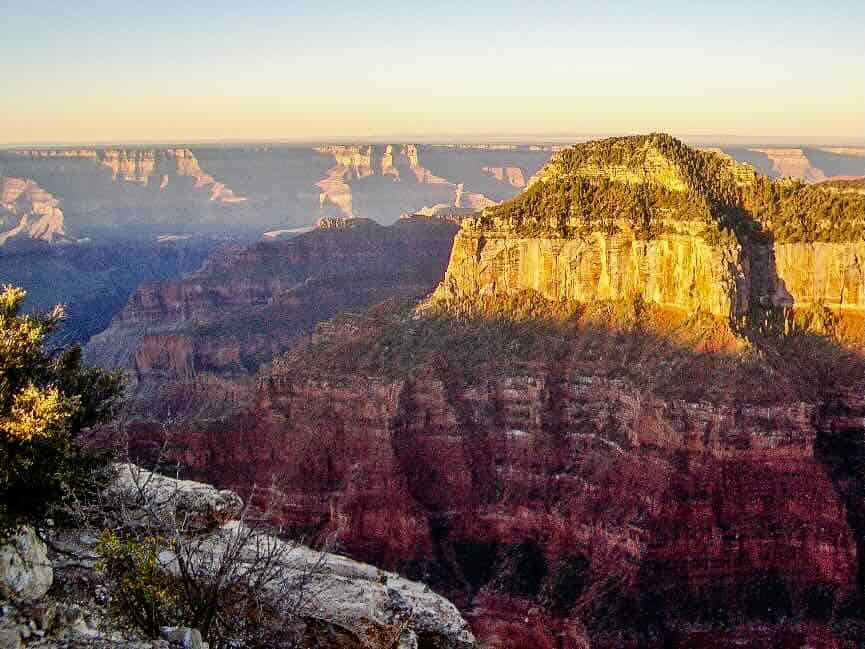
Bright Angel Point is a wonderful (and convenient) spot for sunrise that includes classic North Rim views. Wear a jacket because even summer morning temperatures can be chilly as you walk from the trail from Grand Canyon Lodge. Also bring a flashlight for walking in the dark before the sun rises.
Bright Angel Point makes a good sunset spot, too. You’ll want to bring a flashlight for walking back in the dark.
The back porch at Grand Canyon Lodge is a comfortable place to watch the sunset. Photographers will find it more challenging due to the number of people milling around. Since this is a very popular spot, arrive early to claim your space.
Cape Royal or Point Imperial are good candidates for sunrise and sunset photos, if you’re willing to drive Cape Royal Road in the dark to arrive either before sunrise or after admiring the last colorful hues of a sunset.
Boomer Travel Tip
Did you know that you can color the Grand Canyon in the pages of Coloring the West, An Adult Coloring Book for Travelers? It’s the next best thing to being there.
Plan your visit to the North Rim of the Grand Canyon
The North Rim of the Grand Canyon is open from approximately May 15 to late October (check here for specific dates). Opening and closing dates are dependent on the weather and amount of snow.
Like most national parks, your trip requires planning. Lodging books up far in advance. And, of course, you’ll need a National Park Pass.
At this time, no advanced reservations are required to drive into the North Rim. However a day pass is required to visit Tuweep (Toroweap) as I mentioned earlier in this article.
Where to stay at the North Rim: Grand Canyon North Rim Lodging

Although only 10% of visitors to Grand Canyon National Park make it to the North Rim due to its isolated location (which also makes it feel more like an off-the-beaten-path national park experience), park lodging books up quickly, more than a year in advance.
Accommodations are basic—log cabins with no telephones, television and very limited cell service. You can book them here.
You’ll find an assortment of accommodations: Frontier cabins, motel rooms, Pioneer cabins (some are Rimside), and Western Cabins (some have Rim views). If I were staying for more than a night or two, I would choose a Western Cabin, but of course those book up way early.
When Alan and I visited we were lucky enough to arrange a last minute booking in one of the Frontier cabins that included one double bed and one single bed with little space left over.
Of course if we were campers, we could have stayed in the campground, if a reservation had been available (no hook-ups).
But who cares about luxury lodging with a Grand Canyon view steps from the cabin? We walked the short path to Bright Angel Point to catch the sunrise before chowing down on an asparagus omelet in the dining room of the Grand Canyon Lodge.
Designated a National Historic Landmark, the stone and timber building appears to melt into the environment. In the late afternoon, we sat on the lodge’s veranda overlooking the canyon waiting for a sunset show as the wind rustled through the trees to the click, click, click of camera shutters.
Where to stay outside of Grand Canyon National Park North Rim
Kaibab Lodge (book here) on Highway 67 is the closest lodging to the North Rim that’s outside of the park (only 5 miles from the entrance). You’ll find log cabins in the pines of the North Kaibab National Forest, plenty of wildlife viewing opportunities, and a restaurant.
Jacob Lake, Arizona
Located 45 minutes from the North Rim on Highway 89A just before the turn off to Highway 67, Jacob Lake is the closest community to the North Rim of the Grand Canyon. You won’t find much of a lake here, especially during drought years, but you will find a place to sleep, eat, and fuel up.
Jacob Lake Inn offers the only accommodations in this small settlement. The Inn has hotel rooms, motel rooms, and cabins as well as dining and a gas station. Of course you’ll want to purchase a cookie, a very popular purchase at Jacob Lake Inn.
Kanab, Utah
Kanab, on Highway 89 near the junction of Highway 89A, is about 1 hour and 30 minutes from the North Rim (80 miles). If you’re looking for a place to stay that’s convenient to Zion and Bryce National Parks, as well as the North Rim, Kanab makes a good headquarters with a variety of accommodations.
- Canyons Boutique Hotel: The Victorian-themed boutique hotel offers charming luxury rooms with contemporary amenities. Enjoy breakfast at the Origins Breakfast Buffet ($10 for adult guests, $12 for the general public). Free bike rentals are available for exploring Kanab.
- Parry Lodge: Hollywood stars have stayed in this historic hotel since 1931. Yes John Wayne and Frank Sinatra stayed here. Guests enjoy the free, hot breakfast buffet and pet-friendly rooms.
- Vacation rentals: If you’re planning a multi-day stay in Kanab to visit a number of parks, I recommend a vacation rental (that’s what Alan and I will do on our next visit).
- More Kanab accommodations: You’ll also find a number of bed and breakfasts, as well as a number of chain hotels.
Boomer Travel Tip
Looking for a national parks books reading list? Here are our recommendations for 52 of the Best National Parks Books.
Where to eat at the North Rim
Grand Canyon Lodge Dining Room serves breakfast, lunch and dinner in a room filled with a magnificent view of the canyon (try to sit by the window). Alan and I enjoyed a delicious breakfast, and also dinner, in the dining room.
We found the food to be outstanding, especially considering the remote location. Dinner reservations are recommended, actually these days they are a necessity.
For a more budget-friendly meal, step next door toI Deli in the Pines (open 10 am to 9 pm), where grab and go meals include sandwiches, salads, and made-to-order pizza.
The Coffee Saloon (part of the Roughrider Saloon) is the place to go for a quick breakfast (open 5:30 am to 10:30 pm). You’ll find breakfast burritos, fresh pastries, espresso and coffee.
In the evenings, the patio of the Roughrider Saloon is a scenic spot to enjoy a glass of wine, beer or cocktail.
The North Rim General Store, located at the entrance to North Rim Campground sells basic grocery items. You can also pick up quick breakfast items (warm them up in the general store microwave) or that all important ice cream after a morning of hiking.
Outside of the park, Kaibab Lodge dining room (5 miles from the entrance) serves buffet meals for breakfast and dinner. They also offer grab and go lunches such as sandwiches and burritos.
Or you can drive back to the junction of Highway 67 Highway 89A for a meal at Jacob Lake Inn. Serving breakfast, lunch, and dinner (also to-go options), Jacob Lake Inn dining room provides a sit down meal with interesting options. Kaibab Jagerschnitzel is their specialty.
How to drive to the North Rim of Grand Canyon National Park
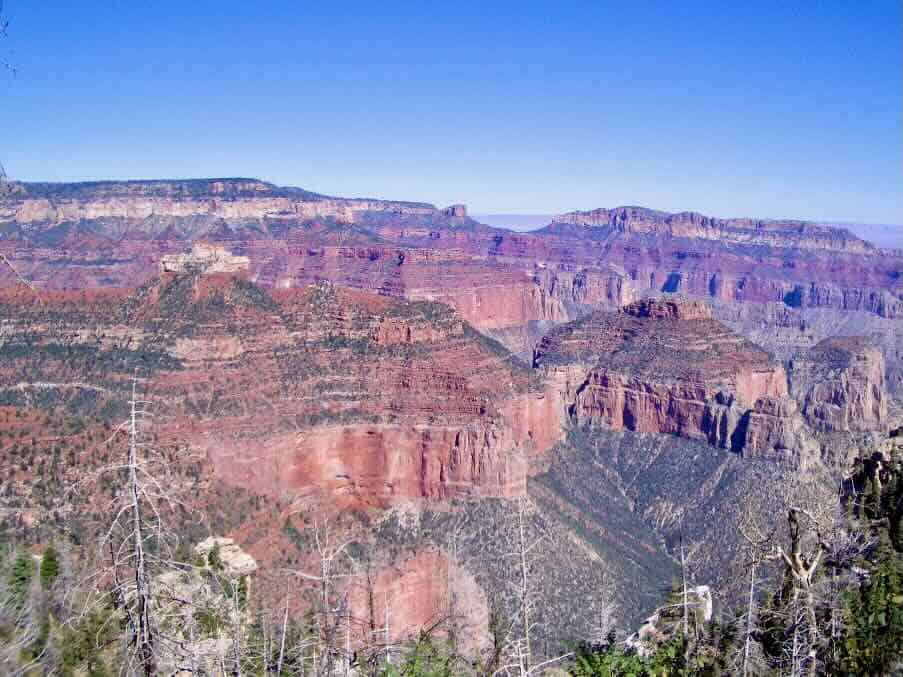
You’ll find the North Rim of the Grand Canyon in Arizona’s northwest corner. The closest community is Jacob Lake located on US 89A. This is the place to fill your gas tank, grab a meal, or even stay for the night at the motel or campground. Don’t blink your eyes or you’ll miss it!
At Jacob Lake, turn south onto the paved Kaibab Plateau-North Rim Parkway (Arizona Highway 67). Enjoy the 44 mile journey through the Kaibab Plateau with its thick ponderosa pine forests fringed with aspen trees.
Watch for wildlife in the sub-alpine meadows that border the road. The luxurious nature filled scene is a far different experience from the high desert landscape of the South Rim.
From the South Rim of the Grand Canyon
If you’re driving from the South Rim Grand Canyon Village to the North Rim (about 220 miles), plan on a 4.5-hour drive (without stops). You’ll be traveling east on the Coconino Plateau (AZ 64) before going north on Highway 89 into the Painted Desert of Navajo land.
Turn west at Highway 89A to continue your scenic drive to the North Rim. The road crosses the Colorado river at Lees Ferry and then skirts the Vermillion Cliffs National Monument, home to White Pocket, Coyote Buttes and the famous Wave rock formation.
After the steep climb through the Kaibab National Forest and onto the Kaibab Plateau, you’ll arrive at Jacob Lake and the turnoff to the North Rim.
From Kanab, Utah
While a one-day visit doesn’t do the North Rim justice, it’s possible (although I don’t recommend it) to see the highlights on a day trip from Kanab. Take Highway 89A for the 80-mile drive to the North Rim (about 90 minutes).
Kanab also makes a convenient headquarters for exploring the trails, dirt roads, and slot canyons of Grand Staircase-Escalante National Monument. And it’s a fun stop on a southwest road trip itinerary that includes Zion National Park (about a 2.5 hour drive) and Bryce National Park (3 hour drive from Kanab).
From Page, Arizona
If you are headquartering in Page, Arizona, the North Rim is a 2.5 hour drive (122 miles) on Highway 89 to Highway 89A to AZ Highway 67. While that’s a lot of driving, this is doable if you only have one day to spend at the Grand Canyon’s North Rim.
Page is also a good choice if you are planning to visit Antelope Canyon, Horseshoe Bend or spend time at Lake Powell.
Boomer Travel Tip
Use our National Park Travel Planner to make the most of your trip!
How to fly to North Rim Grand Canyon
Flying to the North Rim offers the opportunity for a fun road trip (rent your vehicle here) that includes other destinations and national parks in the American Southwest:
- Las Vegas Harry Reid International Airport (275 miles/4.5 hours driving) is the closest international airport to the North Rim.
- Phoenix Sky Harbor International Airport is 350 miles/6 hours driving.
- Salt Lake City International airport is 400 miles/6.5 hours driving
Frequently Asked Questions
The North Rim is open between May 15 and October 15. The North Rim Visitor Center is open daily 8 a.m.-6 p.m.
Entrance fees to the Grand Canyon are $35 for a private non-commercial vehicle that includes up to a 15-person passenger van. The permit is good for 7 days and includes both the North and South Rims. Frequent National Park visitors should consider purchasing an annual pass. The Senior Lifetime Pass is an excellent choice for baby boomers. Purchase passes online here.
A National Park entrance pass is all that is currently required to visit Grand Canyon North Rim. However you will want to reserve lodging ahead of time as it is limited and books up quickly. Due to recent overuse, the drive to Tuweep Overlook (Toroweap) requires a $2 day use permit (in advance) and a National Park Pass. If camping overnight, a backcountry permit is required as well.
A visit to the North Rim deserves more than a day trip. A 3-day, 2-night visit is ideal. You’ll have time to drive the Cape Royal Rd., enjoy several moderate hiking trails, plus enjoy opportunities to photograph sunrises and sunsets. Outdoor enthusiasts should consider a longer visit to see more remote sections of the park.
Temperatures on the North Rim run about 5 to 10 degrees lower than the South Rim during the summer. Due to its higher elevation (8,000 to 9,000 ft), the North Rim receives a good amount of snow during the winter, which is the reason it is closed from around mid October to mid May.
During the winter, all roads on the North Rim are closed to vehicles including snowmobiles. However winter enthusiasts can snowshoe or cross country ski the 45 miles from Jacob Lake. The North Rim campground is also open in winter to those with a backcountry permit.
My favorite month to visit Grand Canyon North Rim is September (also early October) after summer’s temperatures moderate. Late May and early June are good months to visit as long as the winter snow has melted off along the rim trails.
July and August see the most visitors to the North Rim.
Save to Pinterest


